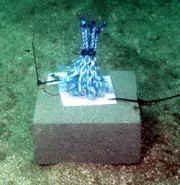School of Biological Sciences (SBS), University of Tasmania (UTAS)
Type of resources
Topics
Keywords
Contact for the resource
Provided by
Years
-
Saltmarshes and other coastal, salt-affected sites were sampled at 63 sites selected to cover the full range of saltmarsh types from all around the Tasmanian coast and on King and Flinders Islands. Sampling was conducted within each of the three saltmarsh zones. A faunal survey was conducted to measure the distribution of crustaceans and molluscs in relation to flora and soil conditions.
-
Rock Platforms on Tasmania's east coast, Flinders Island, and the north coast as far west as Port Sorell, were surveyed between December 1995 and September 1996. At each of 51 sites two transects were sampled using quadrats. All animals and plants were counted, or in the case of sessile species, their cover was estimated.
-
Behavioural syndromes are important in the context of understanding the evolution of behaviour. This study examines the lifetime development of shy/bold behaviour of dumpling squid (Euprymna tasmanica). The first component examined correlations of shy/bold behaviour across two test contexts - a threat and a feeding test, measured 5 times during the lifetime of the squid. The second component examined developmental plasticity in shy/bold phenotypes with age and sexual maturity.
-
This study examined the relationship between personality traits and a number of biological traits in the southern dumpling squid, Euprymna tasmanica. There were 2 contexts in which traits were measured - domain-general or context-specific manner, and four personality traits were measured (shy avoidance-bold aggression, activity, bury persistence and reactivity). Trait expression was context specific, and trait variation was partially explained by maturity and size, but had no links to gender or somatic/reproductive condition.
-

Community assembly in macrofauna communities developed in artificial kelp holdfasts was monitored at 1-month intervals over a 13 month period using a sampling design that used systematic patterns of temporal overlap and changes in start and collection dates. The hierarchical nature of the experimental design allowed several different approaches to analysis; by date of deployment and by date of collection of the artificial habitats, which enabled comparison of community assembly with and without the seasonal effects of the date of collection, and by community age to test whether there were alternative end-states to assembly depending on season or recruitment history.
-
Sandy beaches on Tasmania's east coast, from Catamaran to Cape Portland, were sampled between September 1994 and June 1995. At each of 120 sites the strandline fauna was sampled using pitfall traps set overnight during the low tide period. A number of physical and biotic characteristics of each beach were also measured.
-
This study used crosses of wild-caught dumpling squid (Euprymna tasmanica) males to multiple females with known behavioural types to evaluate patterns of additive and residual variance in behavioural traits from offspring under two contexts - a threat and a foraging test. Genetic contributions to behavioural expression were context-dependent. Threat context behaviour had significant heritability, while foraging context behaviour had lesser additive and greater residual components. Female trait variation was not correlated with fecundity. Female foraging boldness (which co-varied with size) explained some variation in brood hatching success. Positive assortion of mate pairs according to shy-bold phenotype determined fertilization success.
-
Sandy beaches on the north and west coasts of Tasmania, and on Flinders and King Islands were sample between October 1996 and August 1997. At each of 102 sites the strandline fauna was sampled using pitfall traps set overnight during the low tide period. A number of physical and biotic characteristics of each beach were also measured.
 IMAS Metadata Catalogue
IMAS Metadata Catalogue